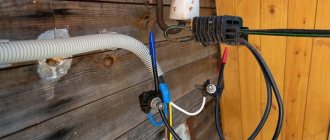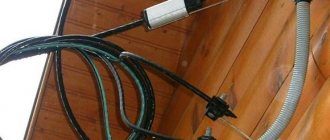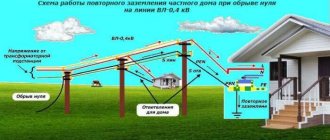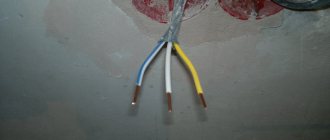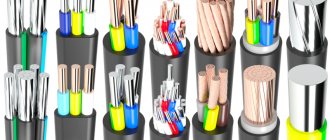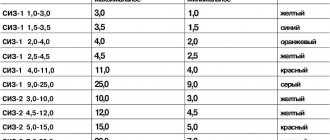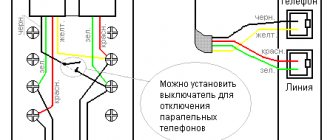To connect objects to the centralized power supply line, wires with an integrated load-bearing element are used that can withstand wind loads. Before connecting the SIP with a copper cable at the entrance to the house, it is necessary to study the regulatory documentation and purchase the necessary components. Switching errors lead to problems with the power supply to the facility.
Features of connecting different wires
Direct connection of copper and aluminum cores is not allowed, since the metals form a galvanic couple. The contact of dissimilar materials has increased resistance, leading to heating of the cables when power is supplied and the load is connected.
Since SIPs are not allowed to be introduced into buildings, internal wiring is carried out on the basis of VVG-NG wire, which does not support combustion. The developer or home owner must correctly connect the aluminum and copper conductors, otherwise the wiring or electrical panel may catch fire.
Connection of SIP with copper cable
This type of connection is used very often. You will definitely encounter it in the following situations: when introducing a copper cable into the house, which must be connected to a self-supporting wire, and when connecting SIP to copper contacts inside the distribution board. Connecting SIP to the copper busbars of the electrical panel is very simple. For this operation, it is necessary to use special tips or washers that prevent contact of aluminum with copper. Of course, tips are technically a more correct option. They are made of two parts, aluminum and copper, fused into one monolithic product.
The tip is crimped onto the SIP core and is easily connected to the copper contact of the distribution board bus. A simpler option is to separate the copper and aluminum with a washer, but such contact is extremely unreliable and is not recommended. Direct installation of SIP on the distribution board terminals is carried out in cases where this device is installed on a power line pole or on the external wall of a building. Inserting the self-supporting wire into the house is used very rarely; copper cables VVG and others are designed for this. In this case, it is necessary to correctly connect the SIP to the copper cable, which we will discuss below.
About connecting cables
SIP cable is used to build power lines and organize branches to residential or industrial buildings. The wire is inserted into a distribution board with a central machine and a meter. The box is placed outside the house (for example, on a concrete or wooden power line support) or inside the building. Depending on the installation location, different methods are used to connect SIPs to copper wiring.
On line support
For SIP branches, piercing clamps are used to ensure the tightness of the contact. To connect a copper cable, you need bimetallic sleeves with subsequent protection of the contact from moisture.
For residential buildings, VVG-NG wire with 3 monolithic cores with a cross-section of at least 10 mm² is most often used (depending on the estimated load power). You should not insert cables of the SIP series into the shield and connect the aluminum conductors directly to the central machine, since it will not be possible to ensure tight contact between the core and the terminals.
On the wall of the house
If the junction box is located on the external wall of the house and is protected from moisture penetration, then bimetallic sleeves can be used. If the shield is mounted indoors, then the SIP is mounted on the wall with an anchor, and then a piece of copper cable with non-flammable insulation is connected (for example, VVG-NG). The wiring is run through a plastic or metal pipe into the house and then connected to the central switch.
The sleeves are insulated with a shrink tube or rubber-based protective tape, which vulcanizes in air and forms a durable layer.
Safety precautions
The SIP cable is manufactured in accordance with GOST 31946-2012, which prescribes the use of wire for organizing outdoor overhead power supply lines. The insulation is made of polyethylene, which is resistant to ultraviolet light and low temperatures, but supports combustion. There is a version of SIP with additional marking with the letter “n”, designed for installation along the wall of the house. The insulator is made of self-extinguishing polymer and does not support combustion. But regardless of the type, the SIP cable cannot be used inside the house.
Connecting insulating clamp for wire price
TK Norma-kabel LLC became the largest NILED dealer at the end of 2019. We have in stock connecting clamps for various sections of SIP at a competitive price. We are ready to offer the maximum possible discounts on the prices indicated in the manufacturer’s price list. For the final price for the connecting insulating clamp for SIP wire, please contact our managers.
LLC TK "Norma-kabel" - goods and equipment for 100% complete set of overhead power lines.
Find out about special offers, product discounts and product availability by phone
Options for connecting dissimilar wires
To connect cables with cores made of dissimilar metals, clamps or couplings are used to prevent direct contact of the materials. Otherwise, an electrochemical couple appears on the connection line. Metals are covered with a layer of oxides that have high resistance, or are destroyed. Since the SIP cores are made of aluminum, and the wiring inside the building is made of copper, reliable separation of materials at the junction lines is necessary.
Piercing type clamps
The clamps are suitable for connecting cores made of dissimilar metals and do not create electrochemical vapors that destroy materials.
For installation, simply insert the wires into the holes and then tighten the bolts. The pointed tips of the clamps pierce the insulation and go deeper into the metal of the core. The clamp body is made of polymer material with the addition of fiberglass to increase strength. The casing protects the contact from moisture and withstands exposure to ultraviolet radiation and precipitation.
Bolted
Bolting technology is used for temporary joining of cables with copper and aluminum conductors, but is not used for SIP. The method is based on installing cores twisted into a ring on the threaded part. To improve the quality of contact, steel washers are placed between the head, nut and mating cores. After tightening, the bolt is protected with a shrink tube or a layer of insulating tape. The resulting connection is not designed for mechanical loads and does not comply with the rules of the PUE.
With terminals
When laying cables inside the house use:
- WAGO terminals with reusable lever clamps. Before switching, the insulator layer is removed from the cores to a length of 8-10 mm. The products provide reliable contact and are not destroyed when connecting a powerful load. The casing does not protect the conductors from exposure to precipitation.
- Walnut-type clamps with a polymer body and metal plates, tightened with screws. WAGO or “nut” clamps can only be used for wiring inside the house; branches from SIPs using terminals are not allowed.
Installation sequence
To connect using GAM bimetallic sleeves you must:
- Remove the insulation from the SIP cable core and put on the coupling.
- Deform the retainer using a 6-sided mandrel, moving the tool along the sleeve and performing successive compressions.
- Strip the copper cable of insulation, insert it into the coupling and secure the cores with a hexagonal mandrel. The length of the exposed area depends on the dimensions of the sleeve.
- Place a shrink tube on the metal elements; to increase the tightness, you can use several protective covers.
If you plan to use clamps, then you need to bring the cable to the wall of the house and secure it with an anchor. Then a clamp is put on the wires (main and branches) and the bolt is tightened. It is necessary to follow the installation rules: with a weak force on the key, the contact pins do not penetrate well into the cable cores. Protective caps are placed on the exposed ends.
The main line entering the house is laid through a pipe that prevents melt or rain moisture from flowing into the shield.
Errors when working with sleeves
The main problems when using sleeves are:
- the use of couplings with an internal hole that does not correspond to the diameter of the metal core;
- the use of connectors cut into several parts (for example, for the purpose of economy or in the absence of the necessary stock of components on site).
The use of sleeves with a small cross-section
Installation of a sleeve with an insufficient cross-section requires a reduction in the diameter of the wire. As a result, the power supply line cannot withstand the rated load, the contact overheats and is destroyed. Removing part of the metal from the core negatively affects the mechanical strength of the cable. Under the influence of wind loads, the core breaks, and special equipment is needed to locate the damage.
The sleeves are too wide
Installing a tip with an increased diameter will not allow you to tightly enclose the metal core of the cable. Winding the wire or bending the end of the strand can partially eliminate the problem, but in this way it will not be possible to increase the mechanical strength of the contact. When connecting powerful equipment to the power line, sparks appear in a poorly crimped joint, carbon deposits cause an increase in resistance and heating of the coupling until the insulation ignites.
Cutting shells
To reduce costs, novice installers cut metal sleeves into several parts. Manufacturers prohibit shortening connectors, since the short length of the clamp will not allow the wiring to be firmly connected. It is inconvenient to squeeze sections of sleeves with pliers; poor compression contributes to the appearance of sparking in the contact when a powerful load is connected. Subsequently, the house owner will have to reconnect the wires, so such “savings” will lead to additional costs.
Connecting insulating clamps for SIP wire (connecting sleeve for SIP)
The quality of power lines directly depends on the quality of the products used to lay them.
Given the increased safety requirements, it is necessary to use products of the highest quality, which are made from the best materials. The safety and reliability of an electrical network with self-supporting insulated wire, which has become widespread in our country, is greatly influenced by the quality of the fittings used. One of the types of fittings for overhead lines up to 1 kV are connecting insulating clamps. The need for their use is caused by the need to connect SIP wires in spans. This need arises when the line consists of several segments of self-supporting insulated wires. Since trading companies usually sell ready-made remnants cheaper than unwinding, it may be advantageous to buy several ready-made lengths plus connecting clamps rather than asking for the entire required length to be unrolled. The use of small lengths of SIPs, which are then connected with sleeves for SIPs, is also explained by ease of transportation and installation features.
We cannot ignore the situation when it is necessary to connect SIP wires of different sections. For this purpose, connecting insulating clamps are used for wires, which have different cross-sections at the ends of the product, corresponding to the cross-sections of the wires being connected. For example, to connect 50 mm2 and 25 mm2 cores in a span, use the MJPT 50.25 connection clamp.
It is important that the connecting clamps provide high levels of tightness at the connection point. Otherwise, the metal may oxidize or moisture may get on the wire, which will lead to its damage. In this case, the service life of the wire will be significantly reduced due to the appearance of rust.
The design features of the connecting clamps allow them to be installed quickly enough, which leads to savings in financial resources. When installing an insulating connecting clamp, a press and dies are used for the corresponding clamp section.
